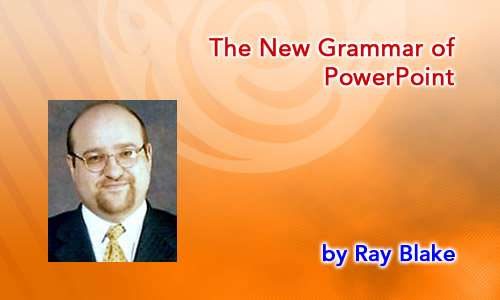Preserving clarity in a bullet-point age
Author: Ray Blake
 Ray is Head of Software Design at GR Business Process Solutions, a UK-based business which provides specialist
services around knowledge testing and skills assessments. He develops and sells Excel, Access and Visual Basic applications,
both as off-the-shelf products and as custom jobs to meet specific client needs.
Ray is Head of Software Design at GR Business Process Solutions, a UK-based business which provides specialist
services around knowledge testing and skills assessments. He develops and sells Excel, Access and Visual Basic applications,
both as off-the-shelf products and as custom jobs to meet specific client needs.
The website he maintains for his company GR Business Process Solutions contains a range of articles of interest to Office developers, and a page of RAQs (‘Rarely Asked Questions’) on Excel and Access.
With three sons all under the age of 6, he gets little time for interests of his own, but seems to get dragged into each of theirs. Consequently, he has built up an impressive knowledge of young persons’ literature, mostly surrounding the adventures of rodents and other small mammals. Although not proud of the fact, he can also name each of the Wild Force Power Rangers. Repairing toys and replacing batteries are activities he has learned to undertake in his sleep.
The bullet-point construction has become ubiquitous in recent years, thanks at least in part to the PowerPoint communication revolution. I have written elsewhere about the mixed blessings of this revolution, but its impact is undeniable. In this article, I’d like to highlight the importance of grammatical standards in bullet-points so that PowerPoint continues to be an aid to communication rather than a barrier.
The challenge which PowerPoint poses is the need to reduce communication to its barest essence, to strip it of all which is superfluous. The bullet-point is almost the atom of ideas in that it cannot be further reduced without losing meaning. Retaining that meaning in the process is, of course, vital, and it is here where grammar has a real contribution to make.
The good news about the bullet-point is that it removes the need for virtually all punctuation. The idea is that if your bullet-point is long enough to need a comma, it is probably too long. Even a list of items which would traditionally have been separated by commas (items such as lists, recitations, inventories and roll-calls) is rendered not with commas, but with sub-bullets, thus:
Items such as:
Note an important grammatical point here. Where sub-bullets complete a grammatical structure begun in the parent like this, they shouldn’t start with a capital letter, since in grammatical terms they simply continue an existing sentence rather than beginning a new one. This can be a challenge, since Word and PowerPoint will usually seek to make capitalisation automatic for you, assuming that a bullet-point will always constitute a sentence. Fortunately, this option can be turned off globally through Tools/AutoCorrect.
Having said that virtually all punctuation is redundant, there is one mark which certainly isn’t. There was one in that last sentence and there’s another in this one. It’s the apostrophe, or course, and there was another just there. The apostrophe has long been the bête-noire of the novice punctuator, and saying that’s all we have to worry about is a little like assuring the captain of the Titanic that other than icebergs, he has nothing to fear.
Still, a few simple rules will keep us on the side of the angels. Rule 1 of apostrophes is that they never pluralize. Now, you will have been presented daily with examples of people trying to do exactly that with them – Book’s for sale , says the sign; my children’s school newsletter commends the boy’s and girl’s for their fundraising efforts; you might pass a fruit and veg stall offering prices for banana’s, orange’s or potato’s (to be fair, even vice-presidents have had trouble with their vegetable plurals over the years.) All of these usages, of course, are wrong. It is books which are sold; boys and girls should be congratulated; my greengrocer can sell me bananas , oranges and potatoes.
So when do we use the apostrophe? Rule 2 is that an apostrophe denotes ownership. For instance, “I borrowed Karen’ s ruler to measure the box’s dimensions.” If there were more than one box I needed to measure, it would be the boxes’ dimensions. Note that when the word is a plural ending in the letter S, then merely an apostrophe indicates the ownership, rather than another S as well. But when the word is not a plural, but just happens to end in S, the second S is employed, thus:
James’s dinner party
Mr Jones’s wallet
The heiress’s millions
Just to nail down this distinction fully, let’s now imagine that there are 5 Jameses in the room, a number of Mr Joneses and several heiresses. We could now talk about:
The Jameses’ dinner party (if they were all having a joint one)
The Jameses’ dinner parties (if each planned to host his own)
The Joneses’ wallet (if only one between them) or wallets (if each had his own)
The heiresses’ millions
This dropping of the S after an apostrophe only applies to plurals ending in S, and there are a few plurals in English which do not. This is why, when I referred a few paragraphs ago to the school attended by my children, I spoke of “my children’s school”, keeping the ownership S despite the plural.
I think it is because of the importance of the apostrophe in indicating ownership that the greatest abuse of the poor
apostrophe arises. I’m speaking here of the great its vs. it’s problem. We often see constructions like, The baby looks like it’s father. You see the apostrophe there in it’s? It shouldn’t be there. And yet it
seems so sensible, doesn’t it? It is after all indicating ownership, and we know this is a legitimate use of the
apostrophe.
But its is a special breed of word called a possessive pronoun. Let’s replace it in the sentence with an
alternative possessive pronoun to get, The baby looks like his father. You see the point? Just like his,
her, your and their, its in this context takes no apostrophe.
Rule 3 will help us understand when to use it’s with its apostrophe. It is that when you contract two words into one, the apostrophe keeps the place of the missing letters. Because this article is relatively informal in tone, you’ll have read a number of such contractions in it already. Overleaf are all the ones I’ve used so far, plus a few more.

Microsoft and the Office logo are trademarks or registered trademarks of Microsoft Corporation in the United States and/or other countries.